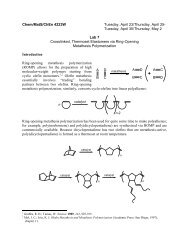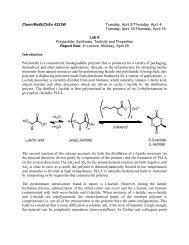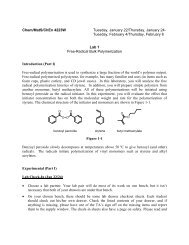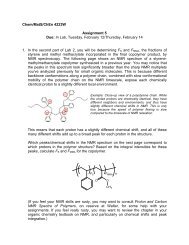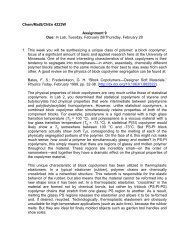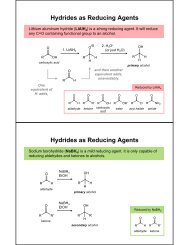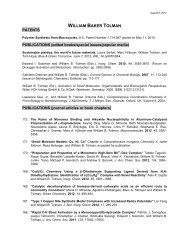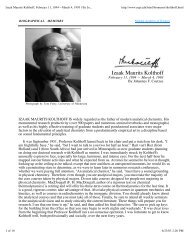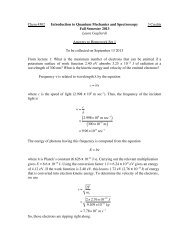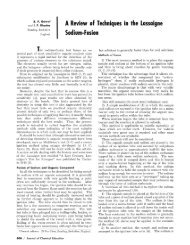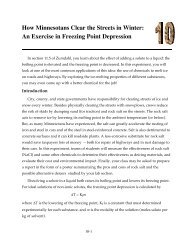Ion-Selective Electrodes With Ionophore-Doped Sensing Membranes
Ion-Selective Electrodes With Ionophore-Doped Sensing Membranes
Ion-Selective Electrodes With Ionophore-Doped Sensing Membranes
You also want an ePaper? Increase the reach of your titles
YUMPU automatically turns print PDFs into web optimized ePapers that Google loves.
<strong>Ion</strong>ophore-doped sensing membranes 2547<br />
Cl<br />
F 3 C<br />
CF 3<br />
Cl<br />
CF 3<br />
Cl<br />
B<br />
Cl<br />
F 3 C<br />
F 3 C<br />
B<br />
CF 3<br />
N +<br />
CF 3<br />
CF 3<br />
Figure 7<br />
Common highly hydrophobic ionic sites used to dope ISE membranes.<br />
Membrane<br />
Sample<br />
R − R − R − R − R − R −<br />
K + K + K + K +<br />
K + K +<br />
K + Cl − K + Cl −<br />
(a)<br />
(b)<br />
Figure 8 Equilibrium ion distribution between an aqueous KCl solution and an ISE membrane with a ratio of K + ionophore and<br />
cationic sites of (a) 1 : 2, and (b) 2 : 1.<br />
used in an optimized ratio to the ionophore can improve the<br />
selectivity (Section 5.2). 53<br />
Note that the concentration of ionic sites has to be low<br />
enough so that the organic phase contains a substantial<br />
concentration of free ionophore. For example, consider an<br />
organic phase prepared to contain an anionic site and an<br />
electrically neutral ionophore that binds K + with 1 : 1 stoichiometry.<br />
If the molar ratio of ionic sites and ionophore<br />
is 2 : 1 and the organic phase is equilibrated with an aqueous<br />
KCl solution, all of the ionophore will be present in<br />
the form of K + complexes, and only half of the K + ions<br />
will be able to bind to an ionophore (Figure 8a). Because<br />
of the very substantial concentration of uncomplexed K +<br />
in the organic phase, the phase boundary potential will be<br />
identical to the one observed for an ionophore-free organic<br />
phase containing only ionic sites. On the other hand, if the<br />
molar ratio of ionic sites and ionophore is 1 : 2 and the<br />
organic phase is equilibrated with an aqueous KCl solution,<br />
half of the ionophore will be present in the form of<br />
K + complexes, half of the ionophore is in its uncomplexed<br />
form (Figure 8b), and the phase boundary potential exhibits<br />
the selectivity characteristic for an ionophore-doped organic<br />
phase. This latter situation is similar to the one of pH<br />
buffers, which only exhibit good buffering capacities if they<br />
contain substantial concentrations of both an unprotonated<br />
base and the conjugated acid (i.e., the proton complex of<br />
the conjugated base). Following this analogy, we can simplify<br />
the above statement that “a Nernstian ISE response<br />
requires that the activity of the ion of interest in the bulk<br />
of the water-immiscible sensing phase is constant and does<br />
not depend on the sample.” More succinctly, a Nernstian<br />
ISE response requires that the ionophore and the ionic sites<br />
buffer the ion of interest in the sensing phase.<br />
3.1.3 The conventional ISE measurement<br />
As shown above, the phase boundary potential at the<br />
interface between an aqueous sample and the hydrophobic<br />
sensing phase of an ISE membrane depends logarithmically<br />
on the activity of the ion of interest in the aqueous<br />
sample (3). However, an experimental method to measure<br />
this phase boundary potential directly does not exist. The<br />
reason why potentiometric measurements, nevertheless,<br />
exhibit the same logarithmic dependence on the activity of<br />
the ion of interest in the sample is illustrated in Figure 9.<br />
The actual potentiometric measurement determines the<br />
EMF as the difference in the electrical potentials between<br />
the connecting wire of the ISE and the connecting wire<br />
of a reference electrode. As in every electrochemical<br />
cell, the EMF is the sum of two types of components:<br />
One type of contributions to the measured EMF arises<br />
from the phase boundary potentials at all interfaces of<br />
the electrochemical cell. Figure 9 illustrates the various<br />
phase boundary potentials present along the path from the<br />
copper connector of a typical ISE through the selective<br />
electrode, the sample, and the reference electrode. These<br />
phase boundary potentials include interfaces of different<br />
types, such as metal–metal, metal–salt, salt–liquid, and<br />
liquid–liquid interfaces. The other types of components<br />
that contribute to the measured EMF of an electrochemical



